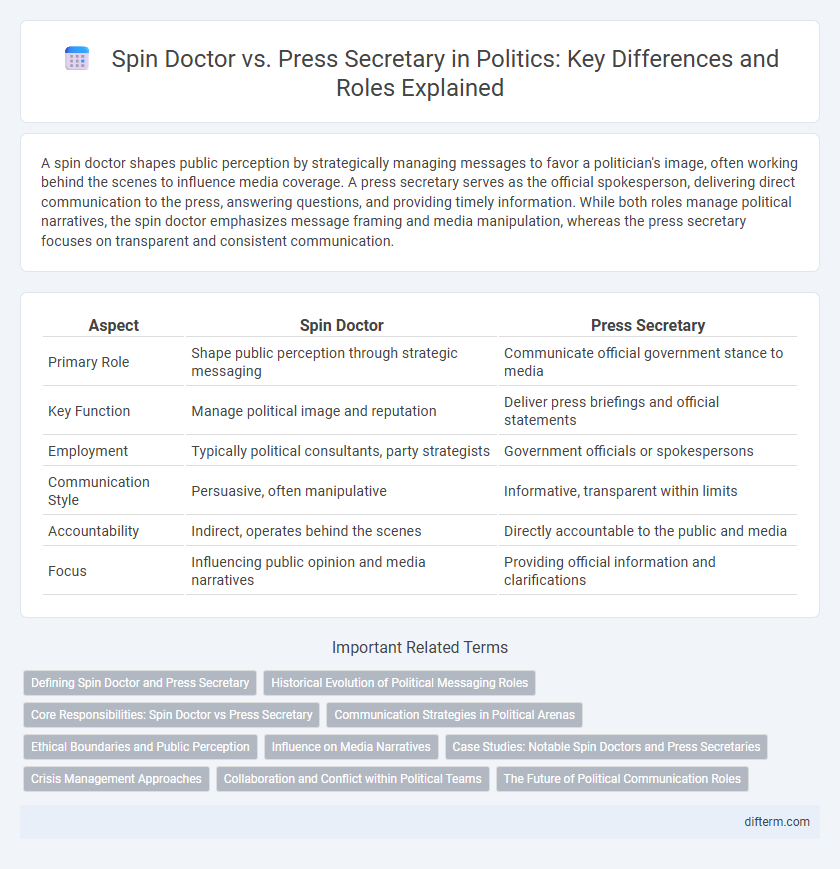A spin doctor shapes public perception by strategically managing messages to favor a politician's image, often working behind the scenes to influence media coverage. A press secretary serves as the official spokesperson, delivering direct communication to the press, answering questions, and providing timely information. While both roles manage political narratives, the spin doctor emphasizes message framing and media manipulation, whereas the press secretary focuses on transparent and consistent communication.
Table of Comparison
| Aspect | Spin Doctor | Press Secretary |
|---|---|---|
| Primary Role | Shape public perception through strategic messaging | Communicate official government stance to media |
| Key Function | Manage political image and reputation | Deliver press briefings and official statements |
| Employment | Typically political consultants, party strategists | Government officials or spokespersons |
| Communication Style | Persuasive, often manipulative | Informative, transparent within limits |
| Accountability | Indirect, operates behind the scenes | Directly accountable to the public and media |
| Focus | Influencing public opinion and media narratives | Providing official information and clarifications |
Defining Spin Doctor and Press Secretary
A spin doctor is a political communications expert skilled in shaping public perception by strategically managing and often manipulating information to favor a particular political agenda. A press secretary serves as the official spokesperson for a politician or government agency, responsible for delivering clear, accurate statements and maintaining media relations. While the spin doctor focuses on influencing public opinion through persuasive messaging, the press secretary emphasizes transparency and consistent communication with the press.
Historical Evolution of Political Messaging Roles
Spin doctors emerged prominently in the late 20th century as political strategists who shaped public perception through media manipulation and crafted persuasive narratives. In contrast, the role of the press secretary has evolved from a straightforward government spokesperson into a sophisticated communicator managing real-time media relations and controlling information flow. This historical evolution reflects the growing complexity and influence of mass media in political messaging strategies.
Core Responsibilities: Spin Doctor vs Press Secretary
Spin doctors specialize in shaping public perception by strategically framing information to influence media narratives and political outcomes. Press secretaries serve as official spokespersons, managing communication between politicians and the press, ensuring accurate dissemination of policies and statements. While spin doctors focus on persuasion and image control, press secretaries prioritize transparency and maintaining consistent messaging.
Communication Strategies in Political Arenas
Spin doctors utilize strategic message framing and rapid response techniques to shape public perception and control political narratives, often operating behind the scenes. Press secretaries act as official spokespersons, delivering consistent and transparent communications directly from political offices to the media and public. Both roles employ tailored communication strategies to influence voter opinion and manage information flow in high-stakes political environments.
Ethical Boundaries and Public Perception
Spin doctors often manipulate information to shape public opinion, risking ethical boundaries by distorting facts for political gain. Press secretaries serve as official communicators, tasked with transparently conveying accurate government positions, maintaining credibility and public trust. The tension between strategic messaging and ethical transparency significantly influences public perception and democratic accountability.
Influence on Media Narratives
Spin doctors shape media narratives by strategically framing political events to favor their candidates, often using persuasive language and selective information. Press secretaries serve as official channels of communication, delivering statements and clarifications that ensure government messages reach the media with accuracy and consistency. Both roles significantly influence public perception, but spin doctors prioritize manipulation of narratives while press secretaries emphasize transparency and factual representation.
Case Studies: Notable Spin Doctors and Press Secretaries
Notable spin doctors such as Tony Blair's Alastair Campbell and Karl Rove, advisor to George W. Bush, have shaped political narratives through strategic media manipulation. In contrast, esteemed press secretaries like Sean Spicer under Donald Trump and Jen Psaki under Joe Biden emphasize transparent communication and crisis management within administrations. Case studies reveal that spin doctors prioritize agenda-setting and perception control, while press secretaries focus on factual dissemination and maintaining government-media relations.
Crisis Management Approaches
Spin doctors prioritize controlling the narrative during political crises by strategically shaping information to influence public opinion and minimize damage to their client's reputation. Press secretaries focus on transparent communication, providing timely and factual updates to maintain credibility and manage media relations effectively. Both roles require rapid response skills but differ in their emphasis on persuasion versus information dissemination in crisis management.
Collaboration and Conflict within Political Teams
Spin doctors and press secretaries play crucial roles within political teams but often experience tension due to differing priorities; spin doctors focus on shaping public perception through strategic messaging, while press secretaries manage official communication and media relations. Collaboration thrives when both professionals align their efforts to create coherent narratives that advance the political agenda, ensuring message consistency across various platforms. Conflicts arise when spin doctors push aggressive framing that may jeopardize the press secretary's credibility with journalists, requiring delicate negotiation to balance persuasion with transparency.
The Future of Political Communication Roles
The future of political communication roles will see spin doctors evolving into strategic narrative architects who utilize advanced data analytics and AI to shape public perception. Press secretaries are expected to transform into real-time communication facilitators, leveraging multimedia platforms for immediate and transparent engagement with diverse audiences. These shifts underline a growing emphasis on authenticity and rapid response in political messaging ecosystems.
Spin doctor vs Press secretary Infographic

 difterm.com
difterm.com